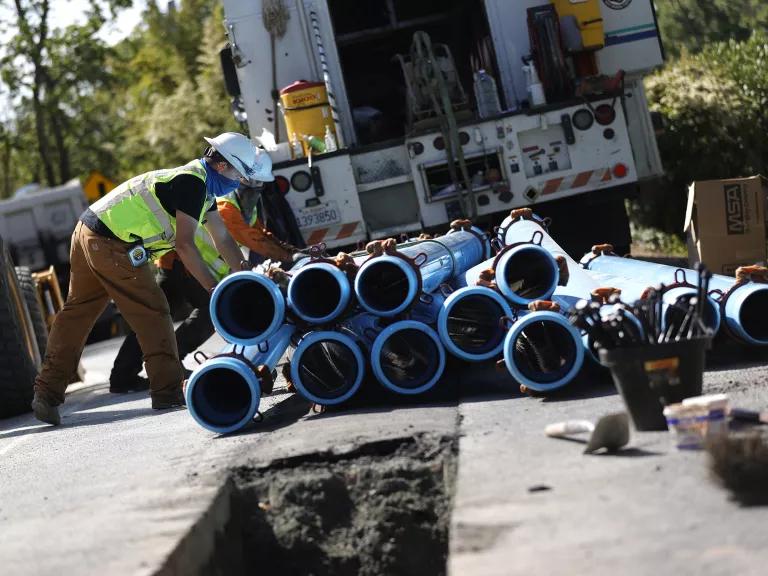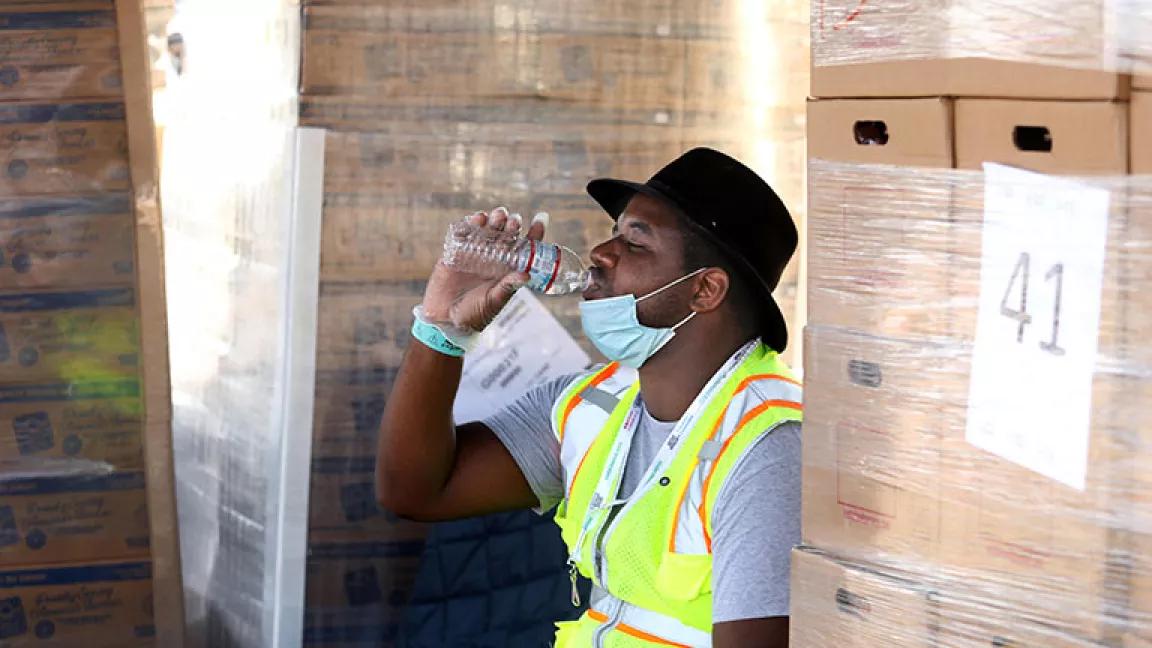Defending Public Health
NRDC shines a light on growing risks—from exposure to harmful chemicals in our clothes, drinking water, and air to the health hazards of climate change—and delivers solutions.
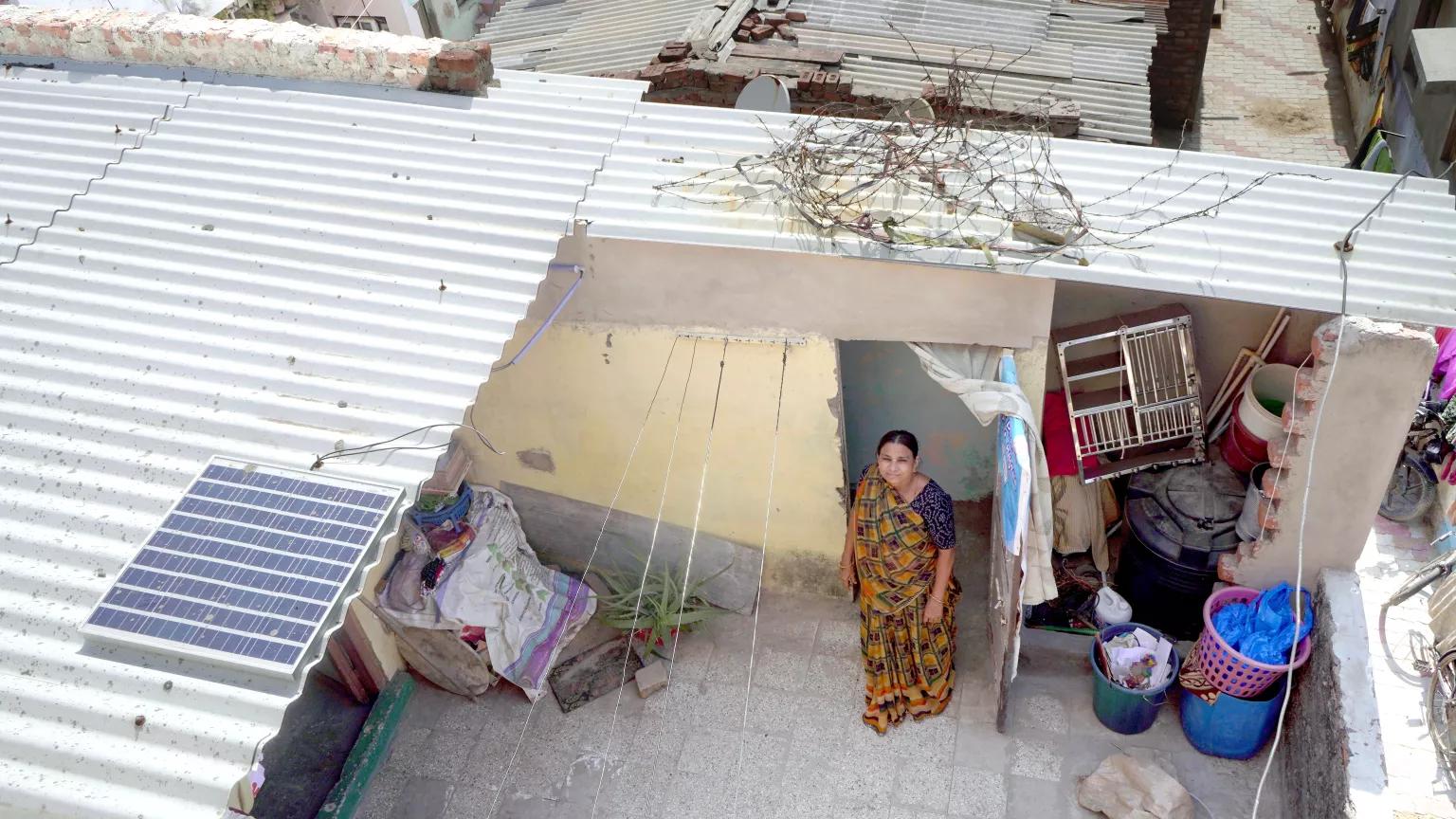
In India, cool roofs, which reflect sunlight and absorb less heat, are a cost-effective way of keeping indoor temperatures lower, thereby decreasing the dependence on air conditioners. They can keep indoor temperatures lower by 3.6 to 9°F compared to traditional roofs.
Mahila Housing Trust
At its core, the public health crisis we face is an intersectional one—shaped by the impacts of the climate crisis, the growing inequity, and the destruction of critical ecosystems. NRDC remains committed to addressing these problems at their sources while defending basic human rights: safe water to drink, clean air to breathe, and a healthy home to live in. The progress we made in 2022 shows that we can continue to deepen societal awareness of the growing health risks of climate change and make the changes we need to see. We also made strides in the fight to rein in the threat of toxic chemicals and right the disproportionate harms that fall on the shoulders of the most underserved communities.
Tackling Toxic Threats
Lead is a potent neurotoxin that’s particularly harmful to children, and there is no safe level of exposure. For the past three decades, the Lead and Copper Rule (LCR), a U.S. Environmental Protection Agency (EPA) safeguard intended to control lead levels in drinking water, has failed to protect people across the country. That could soon change: In a major victory for public health, the EPA announced in December that it will no longer defend the weak version of the LCR set by the Trump administration. Nearly two years after NRDC, along with partner groups and 10 state attorneys general, took the agency to court, the EPA is now promising an improved rule to adequately control lead levels in our drinking water and an analysis of related environmental justice issues. The development also includes the possibility that EPA will require replacement of all the estimated 9 to 12 million lead service lines—the primary culprit of lead contamination—still in use across the country.
Lead is far from the only toxic threat looming across the United States. Thousands of per- and polyfluoroalkyl substances, collectively known as PFAS and considered “forever chemicals,” pose a major risk to our health. They are harmful even at extremely low doses and have been linked to cancer, reproductive problems, and developmental issues. And perhaps unsurprisingly—since they are extremely persistent in the environment and our bodies—they are everywhere, including in the blood of nearly every person in the United States. NRDC experts have been sounding the alarm over the impacts of these harmful chemicals for years, and pressing to phase out unnecessary uses of the chemicals, such as in firefighting foam, rugs and carpets, paper-based food packaging, and textiles.
In April, we released a report on the use of PFAS by the fashion industry, which also included a scorecard grading specific brands’ PFAS policies and commitments. It highlighted the prevalence of forever chemicals in apparel marketed for their water- and stain-resistant properties. In response, several brands, such as Patagonia and L.L.Bean, have either eliminated, or made specific commitments to eliminate, toxic forever chemicals from their merchandise. And in July, following our digital advocacy campaign targeting Columbia Sportswear (which received an F scorecard rating), we joined with the U.S. Public Interest Research Group (U.S. PIRG) Education Fund to deliver 48,000 petition signatures to the company’s CEO, calling on him to publicly commit to phasing out PFAS. The company has since communicated to NRDC and U.S. PIRG that it intends to stop using the chemicals by the end of 2024.
In tandem with this market-based work, we’ve been continuing to influence change at the state policy and supply chain levels to rein in the use of PFAS. Toward this end, our advocates recently celebrated a success in California when Governor Gavin Newsom signed a law in September banning PFAS in most clothes and textiles by 2025. Meanwhile, Governor Kathy Hochul closed out 2022 by signing a law that will ban the manufacture and sale of apparel containing PFAS in New York. These states represent huge markets, and we expect that their new laws will change the national market too.
Progress came at the federal level in August, when the EPA listed for the first time two forever chemicals, PFOA and PFOS, as hazardous substances under Superfund law. While both chemicals had already largely been phased out of domestic production, the designation will assist with remediation efforts. Erik D. Olson, senior strategic director for NRDC’s work on health and food, called the decision an “important first step toward cleaning up hundreds of contaminated sites and protecting millions of families across the country who are exposed to these toxic forever chemicals.” In the meantime, together with our partners, we’re calling for more comprehensive regulations for PFAS as a unified group of chemicals. And toward that end, over the summer, we helped secure funds in California for the State Water Board to develop a broad-spectrum test for PFAS in drinking water and a drinking water standard to address PFAS as a class. These advancements in the Golden State can serve as important precedents and models for both other states and the federal government alike.
Chemicals lurk in the items our pets wear too. Some collars intended to protect animals from fleas and ticks contain dangerous pesticides known to cause cancer and damage to the developing brains of children and fetuses. Our experts first exposed the dangers back in 2000, and a follow-up report nine years later showed residue from those chemicals can be found on pets’ fur at levels that are dangerous for kids. The risk of exposure is great: Nearly two-thirds of people in the United States own pets. Young children who live with dogs and cats are especially vulnerable, given their tendency to put their hands in their mouths. Based on the 2009 analysis, NRDC petitioned EPA to ban two pesticides, propoxur and tetrachlorvinphos (TCVP), from pet products. As a result, EPA announced in 2014 a phaseout of propoxur flea collars but refused to act on the TCVP products, even though the agency’s own December 2016 assessment found there were risks to kids. To fill the gap, we began direct outreach to large pet product retailers. These efforts paid off: Two of the largest companies, Petco and PetSmart, responded, announcing last year that they would stop selling flea collars with TCVP. And in October 2022—in response to a federal court ruling in April that agreed with NRDC that the EPA’s risk analysis of TCVP was inaccurate—EPA announced that it was granting our petition to ban collars with this chemical and would begin the regulatory process to take them off the market.
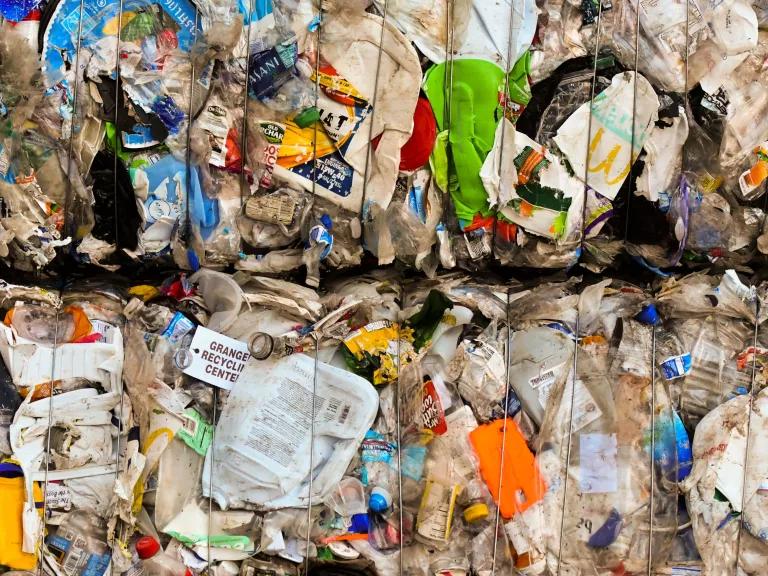
An NRDC study showed that “chemical recycling” facilities generate hazardous waste and exacerbate environmental injustices under the false guise of recycling.
Matthew Dae Smith/USA TODAY NETWORK
NRDC has also recently raised awareness about new sources of toxic chemical exposure from outside the home. In a February 2022 report entitled Recycling Lies: “Chemical Recycling” of Plastic Is Just Greenwashing Incineration, NRDC senior scientist Veena Singla exposed the problematic new technologies the plastics industry is touting as a solution to our plastic waste crisis. The analysis of eight “chemical recycling” plants in the United States found that they are recycling little plastic, that they produce hazardous waste and air pollutants, and that their owners tend to set up shop in communities with disproportionately low income levels, or which are home to predominantly people of color, or both. One of the facilities reported disposing of nearly 500,000 pounds of hazardous waste in 2019, some of which is shipped around the country, jeopardizing the health of anyone in its way.
The waste contains a slew of toxic chemicals, including benzene, a known carcinogen that can harm reproduction and developing fetuses. NRDC’s report has been a helpful tool for advocates and residents who are trying to stop or learn more about the chemical recycling facilities seeking to lay down roots in their communities. One example is the people of Macon, Georgia, who saw through the industry’s lies, thanks in part to the information we shared. In April 2022, the community successfully stopped a company called Brightmark from constructing a 5.3-million-square-foot, $680 million facility—touted as the largest of its kind in the world—and moving into their city.
Meanwhile, on the legislative front, NRDC experts helped ensure that a new law to reduce plastic waste in California included protections to ensure that fake “chemical recycling” does not count as recycling and thereby perpetuate a false solution to the pollution crisis. Advocates see the law’s focus on reducing plastics as an important measure to help reduce exposures to toxic chemicals.
Keeping Workers Safe
Despite climate change fueling hotter, longer, and more frequent heat waves, no federal regulations exist to protect the U.S. workforce from suffering the impacts. Exposure to extreme heat can cause a range of issues, including dehydration, heat stroke, and cardiovascular or kidney failure. The results can be deadly: Between 1992 and 2019, extreme heat killed more than 900 workers and sickened tens of thousands more. While NRDC advocates have pushed for the federal government to address the threat, we have also been working on the state level to help close the gap to make sure workers are protected.
President Joe Biden’s administration directed the Occupational Safety and Health Administration (OSHA) in September 2021 to finally begin working on a national standard. However, because that process can take more than seven years to finalize, there is still urgency for states to act. “By moving faster, states not only help protect workers sooner, but they can actually help OSHA go in the right direction,” says Juanita Constible, a senior climate and health advocate who has been leading our push for heat stress regulations for workers. In May, NRDC released a map that tracks state-level protections to help advocates, reporters, policy analysts, and others identify where heat standards exist or are under development, and what kind of workers are covered. Currently, five states have permanent protections, and several others are working on creating them. And in September, we published a report coauthored by Constible analyzing California’s heat stress standard, the first of its kind in the country, and how it can help inform stronger protections nationwide.
“Deadly heat can strike anywhere, anytime, and we need to be prepared. That includes protecting workers from heat so they can continue to deliver essential services and still make it home safely at the end of each shift.”
Juanita Constible, senior climate & health advocate, People & Communities Program
Farmworkers, who are particularly vulnerable to extreme heat, face an additional health threat in the fields: exposure to toxic pesticides. NRDC has fought for more than a decade to restrict the widespread use of the herbicide glyphosate, the active ingredient in the weed-killing product Roundup. This dangerous chemical has been linked to an increased risk of non-Hodgkin’s lymphoma, a type of cancer, and birth defects; it’s also been identified as a driving factor in the steep decline of the monarch butterfly population due to its decimation of milkweed plants. In 2020, together with our partners, we sued the EPA for rubber-stamping glyphosate’s reapproval and disregarding these scientific warnings. This past June, some good news emerged from our lawsuit. The U.S. Court of Appeals for the Ninth Circuit vacated EPA’s determination that glyphosate “is not likely to be carcinogenic to humans” and required the agency to issue a revised analysis. “EPA must follow the science and protect the people who are forced into close proximity with this dangerous chemical, as well as the wildlife that is indiscriminately impacted by it,” says Lucas Rhoads, a staff attorney for NRDC’s pollinator initiative, about the decision. “This is a huge win for farmworkers fighting to protect their health.”
Addressing Air Pollution in India
In India, poor air quality and air pollution contribute to approximately 980,000 premature deaths every year. To focus more on this pressing challenge, we opened an office in New Delhi after 14 years of engagement in India, under the leadership of Dipa Bagai, the country head of NRDC’s India Program. Among our first engagements there, we hosted a webinar on the topic of "Climate Action in India: Cleaner Air and Better Health.” At the December event, we launched a new fact sheet on the air quality and health co-benefits of climate change mitigation and adaptation in the city of Ahmedabad in northwestern India. Our research makes it clear that assertive clean energy deployment and adaptation measures implemented in Ahmedabad could reduce air pollution, save energy, and avoid more than 1,400 premature deaths annually in 2030—approaches that can be replicated in other Indian cities. The multi-partner research project also shows that Ahmedabad can achieve even more significant health benefits by meeting World Health Organization air quality guidelines, which would result in as many as 17,300 fewer premature deaths citywide in 2030.
Did You Know?
Indian cities struggle with some of the world’s worst outdoor air pollution. Yet there is hope: New research by NRDC, working with leading Indian health and science partners, shows that city-level climate change response measures can produce significant benefits for air quality and health in the near term, even as the economy expands and the population grows.
As India increasingly faces life-threatening heat, the demand for cooling is also increasing. And because the country’s energy needs are projected to double (if not triple) by 2050, climate advocates are racing for solutions to limit an accompanying rise in greenhouse gas emissions. In August, NRDC experts Vijay Limaye, Prima Madan, and Kim Knowlton, in partnership with energy experts in India, published new peer-reviewed research finding that low-cost cool roof installations in Ahmedabad can more than offset the climate warming–related increase in cooling demand the city will see by 2030. Cool roofs are a cost-effective strategy for buildings to absorb less heat and thereby reduce the need for cooling, and they can be made from a variety of materials such as reflective paint, coconut husks, or paper waste. These simple and cost-effective building additions remind us that solutions to help frontline communities cope with the increasingly urgent threat of extreme heat are within reach.
More 2022 Highlights
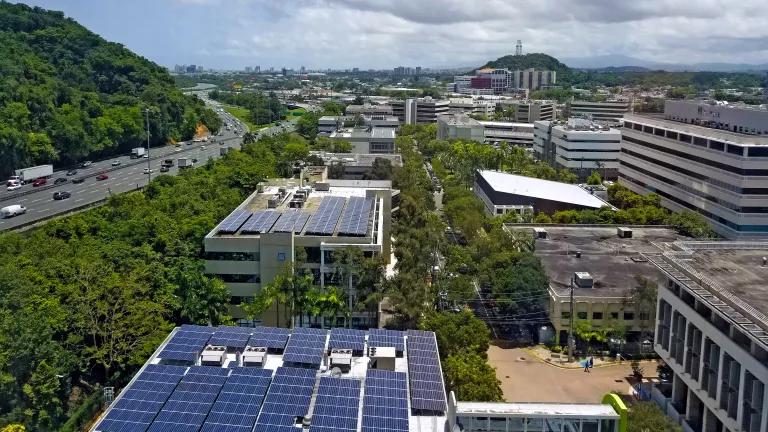
Standing with Communities

Fighting for Our Climate Future

Protecting the Wild
Annual Report 2022: A Turning Point
Explore the rest of our annual report for an overview of what we've accomplished in 2022.


